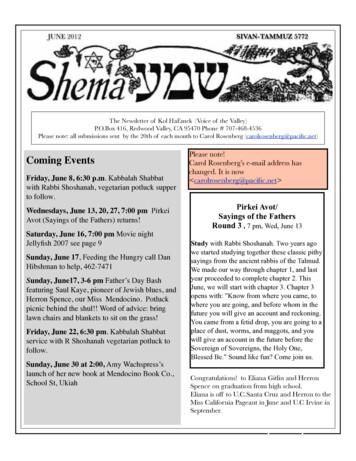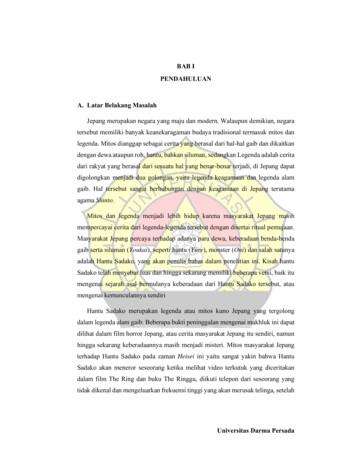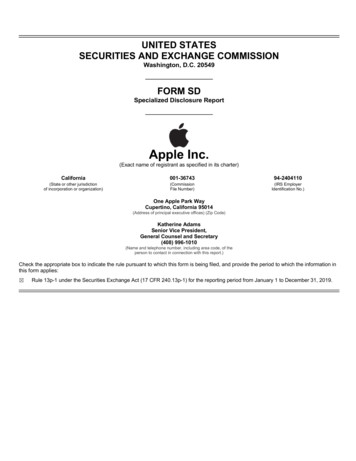Shanshan Yang June 2010 2010 Shanshan Yang. All Rights .
Effect of Paraffins on Carbon Dioxide Corrosion and Water Wetting in Oil-WaterSystemsA thesis presented tothe faculty ofthe Russ College of Engineering and Technology of Ohio UniversityIn partial fulfillmentof the requirements for the degreeMaster of ScienceShanshan YangJune 2010 2010 Shanshan Yang. All Rights Reserved.
2This thesis titledEffect of Paraffins on Carbon Dioxide Corrosion and Water Wetting in Oil-WaterSystemsbySHANSHAN YANGhas been approved forthe Department of Chemical and Biomolecular Engineeringand the Russ College of Engineering and Technology bySrdjan NesicProfessor of Chemical and Biomolecular EngineeringDennis IrwinDean, Russ College of Engineering and Technology
3ABSTRACTYANG, SHANSHAN, M.S., June 2010, Chemical EngineeringEffect of Paraffins on Carbon Dioxide Corrosion and Water Wetting in Oil-WaterSystems (102 pp.)Director of Thesis: Srdjan NesicParaffins are one of the most common components in crude oil. Paraffin wax cangenerate corrosion inhibition by wax formation on the internal surface of the pipeline,reducing the corrosion. Furthermore, paraffin wax is believed to have effects onwettability of steel as well as the interfacial tension of oil and water, with consequentpositive effect on the internal pipeline corrosion.The objective of the study is to experimentally investigate the effect of paraffinson CO2 corrosion rate, wettability and interfacial tension in an oil-water system.Furthermore, the goal was to develop a thermodynamic model to predict the waxappearance temperature (WAT) theoretically.The corrosion inhibition measurements, contact angle measurements andinterfacial tension measurements were conducted at two different temperatures, 30ºC(above the WAT) and 5ºC (below the WAT), using a synthetic paraffin-oil mixture whichis composed of LVT200 and a laboratory grade n-paraffin called Eicosane[CH3(CH2)18CH3] at different concentration, ranging from 0 to 50 wt%. A model forpredicting wax precipitation was proposed by applying thermodynamic principles, massbalances and computational methods.
4It is found that paraffins produce significant corrosion inhibition at temperaturesbelow the WAT. Paraffins change the wettability of steel surface from being hydrophilicto hydrophobic when the temperature is below the WAT. A new thermodynamic modelfor predicting wax precipitation was proposed and agrees rather well with experimentalresults for synthetic normal paraffin oils.Approved:Srdjan NesicProfessor of Chemical and Biomolecular Engineering
5ACKNOWLEDGEMENTSI would like to express the deepest gratitude is to my advisor, Dr. Srdjan Nesic forhis support, guidance and encouragement during my master study at Ohio University.I would also like to express my sincere appreciation to my project leader, Dr.Sonja Richter for her leadership on my research project, Dr. Winston Robbins for hisadvice on paraffins study and Dr. Tingyue Gu for his suggestion on wax precipitationmodel.I appreciate all the faculty, staff and my fellow students at Institute for Corrosionand Multiphase Technology for their support and advice throughout the project. I wouldlike to give special mention to Dr. Chong Li and Mr. Xuanping Tang.
6DEDICATIONToMy father, Jiguang YangandMy mother, Benhong Gong
7TABLE OF CONTENTSPageAbstract . 3Acknowledgements . 5Dedication . 6List of Tables . 9List of Figures . 10Chapter 1: Introduction . 141.1 CO2 corrosion . 161.2 Water wetting . 191.3 Paraffins . 20Chapter 2: Experimental Setup and Procedures. 242.1 Properties of the synthetic paraffin-oil mixture . 252.1.1 Viscosity . 262.1.2 Wax appearance temperature (WAT) . 282.1.3 Density . 302.2 Wax precipitation on the steel surface . 302.3 Corrosion inhibition . 342.3.1 Corrosion inhibition above the wax appearance temperature (WAT) . 372.3.2 Corrosion inhibition below the wax appearance temperature (WAT) . 382.3.3 Effect of shear on corrosion inhibition . 412.3.4 Corrosion inhibition at a varying temperature . 412.4 Wettability . 422.5 Interfacial tension . 47Chapter 3: Results and Discussion. 503.1 Properties of the synthetic paraffin-oil mixture . 503.1.1 Viscosity . 503.1.2 Wax appearance temperature (WAT) . 513.1.3 Density . 523.2 Wax precipitation on the steel surface . 53
83.3 Corrosion inhibition . 553.3.1 Corrosion inhibition above the wax appearance temperature (WAT) . 553.3.2 Corrosion inhibition below the wax appearance temperature (WAT) . 573.3.3 Effect of shear on corrosion inhibition . 613.3.4 Corrosion inhibition at a varying temperature . 633.4 Wettability . 643.4.1 Oil droplet in water phase . 653.4.2 Oil droplet in water phase (oil pre-wet specimen) . 673.4.3 Water droplet in oil phase . 713.4.4 Water droplet in oil phase (oil pre-wet specimen) . 733.5 Interfacial tension . 77Chapter 4: Thermodynamic Model for Wax Precipitation . 784.1 General solid-liquid equilibrium . 794.2 Fugacities of pure substance for liquid and solid at the reference state . 814.3 Activity coefficient model . 834.4 Modeling calculation . 874.5 Model validation . 89Chapter 5: Conclusions . 96References . 97Appendix A: Linear Polarization Resistance . 101
9LIST OF TABLESPageTable 1: Chemical Composition of Carbon Steels (X65 and C1018) .15Table 2: Test Matrix Showing the Concentration of the Synthetic Paraffin-Oil Mixture.26Table 3: Properties of Falling Balls Accompanying with Viscometer .28Table 4: Test Matrix for Wax Precipitation Measurement .33Table 5: Test Matrix for Corrosion Inhibition Measurement .36Table 6: Test Matrix for Contact Angle Measurement .45Table 7: 4 Sets of Experiments for Wettability Measurement .45Table 8: Test Matrix for Interfacial Tension Measurement .48Table 9: Values of Solubility Parameters for Normal Paraffins .85Table 10: Composition of the Synthetic Oil Mixtures Used to Test the Model .90Table 11: Comparison of the WAT between Experimental and Model Results.93
10LIST OF FIGURESPageFigure 1: Solid Eicosane at room temperature .25Figure 2: Setup of the Haake viscometer used to measure the viscosity of the syntheticparaffin-oil mixture .27Figure 3: Setup for measuring the wax appearance temperature (WAT) .29Figure 4: Peltier cooler.31Figure 5: Configuration of cooling apparatus used for measurement of wax precipitationon the steel surface .32Figure 6: Setup for measurement of wax precipitation on the steel surface .33Figure 7: Three electrode glass cell setup using the rotating cylinder as the workingelectrode, silver/silver-chloride (Ag/AgCl) as the reference electrode and theplatinum ring as the counter electrode .35Figure 8: Sketch of the contact angle, θ, of (a) water droplet (water-in-oil) (b) oil droplet(oil-in-water) .43Figure 9: Goniometer setup with the video camera and a backlight.44Figure 10: Test cell of goniometer with a carbon steel (X65) specimen on the specimenholder.44Figure 11: Setup of tensiometer using a platinum ring to measure the interfacial tensionbetween water and oil.48Figure 12: Viscosity of the synthetic paraffin-oil mixture at the ambient temperature . 51Figure 13: Wax appearance temperature (WAT) of the synthetic paraffin-oil mixture.52
11Figure 14: Density of the synthetic paraffin-oil mixture at the ambient temperature .53Figure 15: Weight of wax precipitation as a function of time and oil temperature. (Oilsource: 30 wt% synthetic paraffin-oil mixture. Specimen temperature: 5ºC.).54Figure 16: LPR results of 3 steps of corrosion inhibition measurement for the syntheticparaffin-oil mixture at 30ºC (above the WAT). .56Figure 17: LPR results of the partitioning step for the synthetic paraffin-oil mixture at5ºC (below the WAT) .58Figure 18: LPR results of the corrosion inhibition and persistency step for Procedure 1 at5ºC (below the WAT) .59Figure 19: LPR results of the corrosion inhibition and persistency step for Procedure 2 at5ºC (below the WAT). (Oil source: 30 wt% synthetic paraffin-oil mixture.Specimen temperature: 5ºC.) .60Figure 20: LPR results for testing the effect of shear on corrosion inhibition .62Figure 21: LPR results for testing the effect of shear on corrosion inhibition .63Figure 22: LPR results for testing the effect of increasing the temperature from 5ºC to30ºC on corrosion inhibition .64Figure 23: Droplets of the synthetic paraffin-oil mixture on the surface of carbon steel(X65) in 1 wt% NaCl aqueous solution (water) phase at 30ºC. .65Figure 24: Droplet of LVT200 on the surface of carbon steel (X65) in 1 wt% NaClaqueous solution (water) phase at 5ºC .66
12Figure 25: Contact angle measurements of the droplets of the synthetic paraffin-oilmixture in 1 wt% NaCl aqueous solution (water) phase at 5ºC and 30ºC .67Figure 26: Droplets of the synthetic paraffin-oil mixture in 1 wt% NaCl aqueous solution(water) phase at 30ºC on the surface of carbon steel (X65) which is pre-wettedwith the synthetic paraffin-oil mixture.68Figure 27: Droplets of LVT200 in 1 wt% NaCl aqueous solution (water) phase at 5ºC onthe surface of carbon steel (X65) which is pre-wetted with the syntheticparaffin-oil mixture .69Figure 28: Contact angle measurements of the droplets of the synthetic paraffin-oilmixture in 1 wt% NaCl aqueous solution (water) phase at 5ºC and 30ºC on thesurface of carbon steel (X65) which is pre-wetted with the synthetic paraffinoil mixture .70Figure 29: Water droplets on the surface of the carbon steel (X65) surface in the syntheticparaffin-oil mixture at 30ºC .71Figure 30: Water droplets on the surface of the carbon steel (X65) surface in LVT200 oilphase at 5ºC .72Figure 31: Contact angle measurements of water droplets in the synthetic paraffin-oilmixture at 5ºC and 30ºC .73Figure 32: Water droplets in the synthetic paraffin-oil mixture at 30ºC on the surface ofcarbon steel (X65) which is pre-wetted with the synthetic paraffin-oil mixture.74
13Figure 33: Water droplet in LVT200 oil phase at 5ºC on the surface of carbon steel (X65)which is pre-wetted with the synthetic paraffin-oil mixture .75Figure 34: Contact angle measurements of water droplets in the synthetic paraffin-oilmixture at 5ºC and 30ºC on the surface of carbon steel (X65) which is prewetted with the synthetic paraffin-oil mixture .76Figure 35: Interfacial tension measurements between the synthetic paraffin-oil mixtureand 1 wt% NaCl aqueous solution at 30 C .77Figure 36: Procedure chart of the calculation of thermodynamic model for waxprecipitation.89Figure 37: Experimental and predicted wax precipitation results for synthetic Mixture A.91Figure 38: Experimental and predicted wax precipitation results for synthetic Mixture B.91Figure 39: Experimental and predicted wax precipitation results for synthetic Mixture C.92Figure 40: Wax precipitation results: experiments and new model conducted by adjustingthe ratio of activity coefficient for Mixture A. .94Figure 41: Wax precipitation results: experiments and new model conducted by adjustingthe ratio of activity coefficient for Mixture B .95Figure 42: Wax precipitation results: experiments and new model conducted by adjustingthe ratio of activity coefficient for Mixture C .95
14CHAPTER 1: INTRODUCTIONIn petroleum reservoirs, crude oil is accompanied by natural gas, formation water,mineral salts and a variety of other components, including some corrosive species. Thesematerials are produced in the so called “upstream” operations (wells, pipelines, etc.), andthen transported to the processing facilities (for separation, refining, etc.) – the so called“downstream” facilities. In order to boost the reservoir pressure, the separated formationwater is often re-injected back into the petroleum reservoirs (sometimes mixed withseawater). Therefore, the produced water may continuously accumulate in oilfieldreservoir over the years. Due to the existence of water and corrosive species, the internalcorrosion of transportation pipelines may occur. Economic factors rule out use ofcorrosion resistant alloys (CRAs) due to the high cost. Therefore, due to low cost, easymanufacturing and convenient utilization, carbon steel is used extensively. Table 1 showsthe chemical composition of two types of common carbon steels. However, the lifetimeof carbon steel pipelines is limited by internal corrosion. A recent study performed byNACE International (Cost of Corrosion, 1998) estimated that the cost of corrosion in theUnited States is 276 billion annually including 138 billion of direct cost. A largeportion of that is related to corrosion in transportation utilities with internal corrosion ofpipelines playing a significant role. Therefore, in order to reduce the loss caused byinternal corrosion, it is necessary to understand the phenomena of internal pipelinecorrosion better and qualify the factors that affect it.
15Table 1. Chemical Composition of Carbon Steels (X65 and C1018) (wt%)CX65SiPSMnAlCrCu0.14 0.25 0.013 0.004 1.16 0.031 0.15 0.14C1018 0.20.25 0.009 0.012 0.87 0.022 0.1NiFe0.38balance0.083 0.071 balancePhase wetting regimes are believed to have a relationship with internal pipelinecorrosion. When the corrosive water phase comes in contact with the internal
generate corrosion inhibition by wax formation on the internal surface of the pipeline, reducing the corrosion. Furthermore, paraffin wax is believed to have effects on wettability of steel as well as the interfacial tension of oil and water, with consequent positive effect on the internal pipeline corrosion. The objective of the study is to .
Shanshan Wu, Yanfei Lv, Ge Yu, Yu Gu, and Xiaojing Li A Simple But Effective Event-Driven Model for Data Stream Queries . . . 534 Yu Gu, Ge Yu, Shanshan Wu, Xiaojing Li, Yanfei Lv, and Dejun Yue Spatial and Temporal Databases II Efficient Difference NN Queries for Moving Objects 542 Bin Wan
Conc Diagram- All Failures Cispa Data Avalon Date PCB Lot Number Igarashi TPS date codes. MB Panel Number VIAS Hole Location Failure 9-June'09 11-June'09 923 162 12-June'09 923 163,164 TBD TBD 1 13-June'09 923 164 15-June'09 923 166 16-June'09 923 167 17-June'09 923 168,171 18-June'09 923 171 19-June'09 923 171 20-June'09 923 171 22-June'09 923 173 23-June '09 923 179 24-June '09 923 .
June 16 Shelach Lecha June 23 - Korach June 30 Hukath We Remember Sylvia Marans Elberg - June Vera Meyerhoff - June Daniel Rosenberg - June1 Edward Wandrei - June 6 Helen Feinberg-Ginsburg - June 6 Thelma Cohn - June 12 Wilma Sizemore June - 16 Joseph P. Suffel - June 21 Eliot Rivers - June 31 Paul Aaron Kowarsky - Sivan 14 -
Winter Carnival 14 June P&C Disco 8 17 June Board Meeting 18 June 19 June 20 June 21 June Bletchley Vale Cup 9 24 June Swimming Lessons Yr 3 – 6 P&C Meeting 25 June Swimming Lessons Yr 3 – 6 26 June Swimming Lessons Yr 3 – 6 Pre Primary Junior Olympics 27 June Swimming Lessons Yr 3 – 6 Yr2 Start Smart 28 June Swimming Lessons Yr 3 – 6 10
Pada akhirnya jalur dan kebijakan pembangunan yang lemah di Thailand ini menyebabkan terjadinya krisis ekonomi pada tahun 1997. Krisis . 19 ekonomi ini bukanlah hasil dari satu peristiwa tertentu, tetapi lebih kepada hasil dari suatu proses yang terkait dalam pembangunan yang dilakukan dengan kebijakan-kebijakan yang lemah, institusi dan manajemen yang lemah yang menyebabkan pembangunan yang .
BAB I PENDAHULUAN A. Latar Belakang Masalah Puasa Ramadhan adalah kewajiban sakral dan ibadah Islam yang bersifat syiar yang besar, juga salah satu rukun Islam praktis yang lima, yang menjadi pilar agama.1 Puasa merupakan ibadah agung yang hanya Allah SWT saja yang mengetahui seberapa besar pahalanya. Seorang yang berpuasa juga akan
Lewis Judah Ruskin June 4, 1968 Harlan Cleveland June 4, 1968 Commencement Name or Convocation John Hope Franklin June 3, 1969 Frank Borman June 3, 1969 Charles Stewart Mott Jan 13, 1970 Ernest J. Hopkins June 2, 1970 George Homer Durham June 1, 1971 Richard A. Harvill June 1, 1971 Arthur B. Schellenberg June 1, 1971 Pablo Casals Mar 30, 1972
Section 1 – Conflict Minerals Disclosure Items 1.01 and 1.02 Conflict Minerals Disclosure and Report, Exhibit Conflict Minerals Disclosure A copy of Apple Inc.’s (“Apple’s”) Conflict Minerals Report for the reporting period January 1, 2019 to December 31, 2019 is provided as























